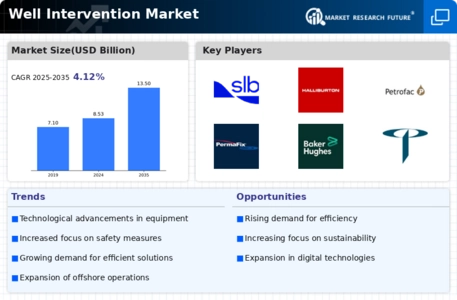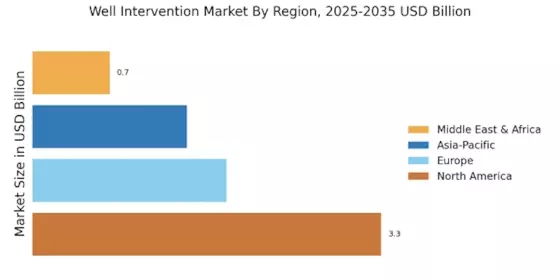Increasing Energy Demand
The rising The Well Intervention Industry. As economies expand and populations grow, the need for oil and gas continues to escalate. According to recent estimates, energy consumption is projected to increase by approximately 30% by 2040. This surge necessitates the enhancement of existing oil and gas wells to maximize output and efficiency. Well intervention services, which include maintenance, repair, and enhancement of well productivity, are essential to meet this demand. Companies are increasingly investing in well intervention technologies to ensure that they can extract maximum value from their existing assets. This trend indicates a robust growth trajectory for the Well Intervention Market, as operators seek to optimize production and extend the life of their wells.
Technological Innovations
Technological innovations are reshaping the Well Intervention Market, offering new solutions to enhance efficiency and reduce costs. Advancements in technologies such as robotics, automation, and data analytics are enabling operators to perform interventions more effectively and safely. For example, the introduction of remote-operated vehicles and advanced monitoring systems allows for real-time data collection and analysis, facilitating timely decision-making. These innovations not only improve operational efficiency but also reduce the risks associated with well interventions. As technology continues to evolve, the Well Intervention Market is expected to witness increased adoption of these advanced solutions, driving growth and enhancing the overall productivity of oil and gas operations.
Focus on Enhanced Oil Recovery
The focus on enhanced oil recovery (EOR) techniques is a critical driver for the Well Intervention Market. As conventional oil reserves become depleted, operators are increasingly turning to EOR methods to extract additional hydrocarbons from existing wells. Techniques such as water flooding, gas injection, and thermal recovery are gaining traction, necessitating regular well interventions to implement and optimize these processes. The global push for energy security and the need to maximize output from existing fields further underscore the importance of EOR. As a result, the Well Intervention Market is likely to experience robust growth, driven by the increasing adoption of EOR strategies aimed at extending the productive life of oil and gas assets.
Aging Oil and Gas Infrastructure
The aging infrastructure of oil and gas wells presents a significant challenge and opportunity for the Well Intervention Market. Many wells are reaching the end of their productive life, necessitating intervention to maintain or enhance output. It is estimated that a substantial percentage of existing wells are over 20 years old, which often leads to declining production rates. Well intervention techniques, such as workovers and stimulation, are crucial for revitalizing these aging assets. The need for regular maintenance and upgrades to ensure safety and efficiency further drives the demand for well intervention services. As operators strive to prolong the life of their wells, the Well Intervention Market is likely to experience sustained growth, driven by the necessity to address the challenges posed by aging infrastructure.
Regulatory Compliance and Safety Standards
The Well Intervention Market is significantly influenced by stringent regulatory compliance and safety standards. Governments and regulatory bodies worldwide are increasingly enforcing regulations to ensure safe and environmentally responsible operations in the oil and gas sector. Compliance with these regulations often requires regular well interventions to address safety concerns and environmental impacts. For instance, the implementation of stricter emissions standards has prompted operators to invest in well intervention technologies that minimize environmental footprints. This regulatory landscape not only drives demand for well intervention services but also encourages innovation within the industry. Companies that prioritize compliance and safety are likely to gain a competitive edge, further propelling the growth of the Well Intervention Market.


















Leave a Comment